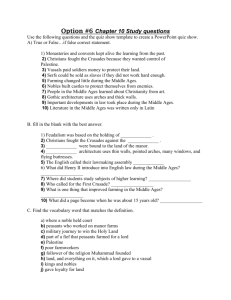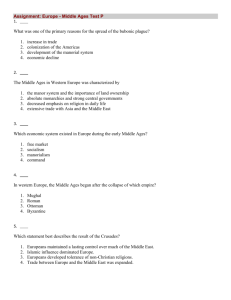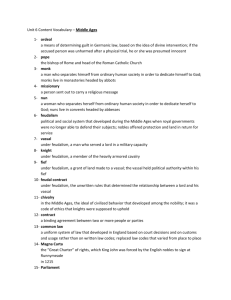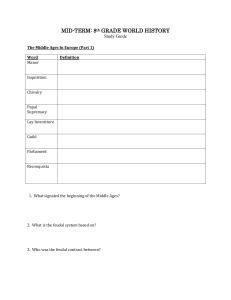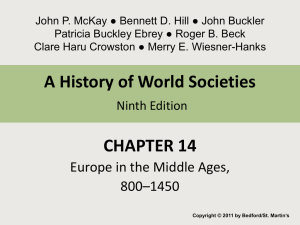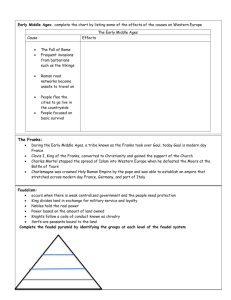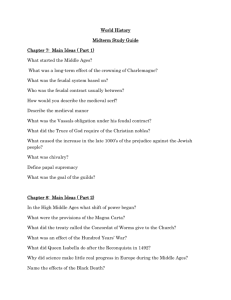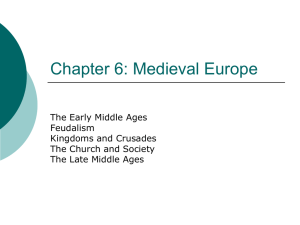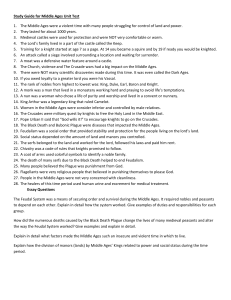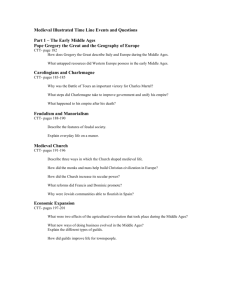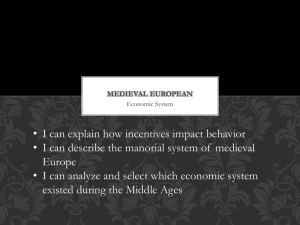Middle Ages in Europe Worksheet | History Study Guide
advertisement
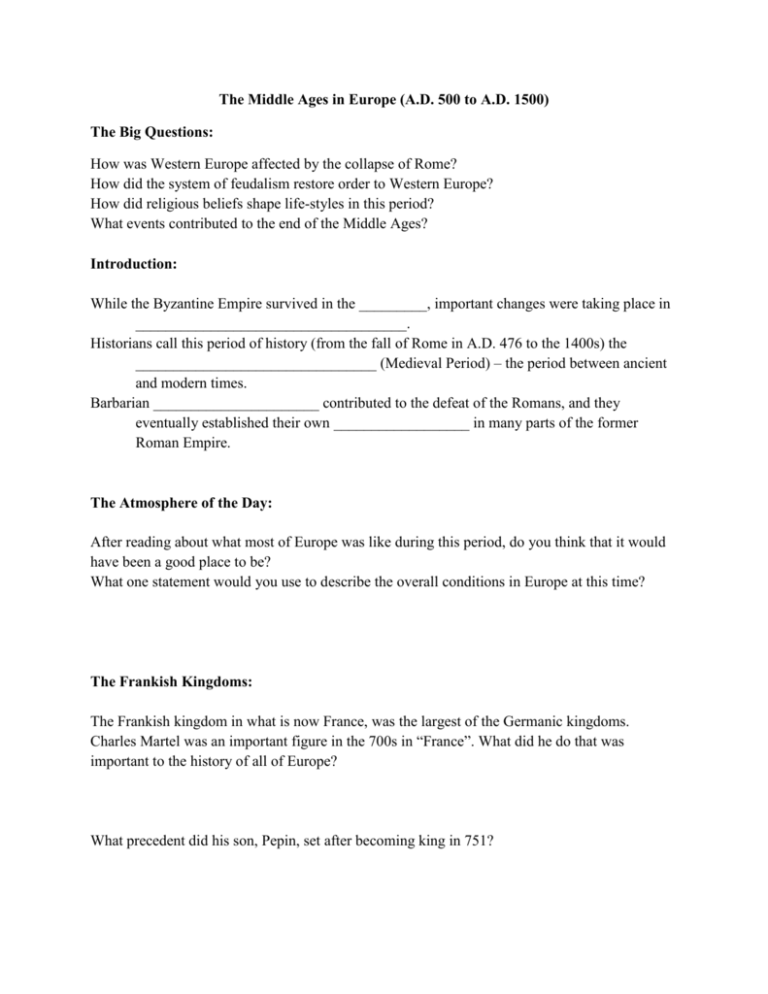
The Middle Ages in Europe (A.D. 500 to A.D. 1500) The Big Questions: How was Western Europe affected by the collapse of Rome? How did the system of feudalism restore order to Western Europe? How did religious beliefs shape life-styles in this period? What events contributed to the end of the Middle Ages? Introduction: While the Byzantine Empire survived in the _________, important changes were taking place in ____________________________________. Historians call this period of history (from the fall of Rome in A.D. 476 to the 1400s) the ________________________________ (Medieval Period) – the period between ancient and modern times. Barbarian ______________________ contributed to the defeat of the Romans, and they eventually established their own __________________ in many parts of the former Roman Empire. The Atmosphere of the Day: After reading about what most of Europe was like during this period, do you think that it would have been a good place to be? What one statement would you use to describe the overall conditions in Europe at this time? The Frankish Kingdoms: The Frankish kingdom in what is now France, was the largest of the Germanic kingdoms. Charles Martel was an important figure in the 700s in “France”. What did he do that was important to the history of all of Europe? What precedent did his son, Pepin, set after becoming king in 751? Charlemagne (Pepin’s son): Charlemagne is Latin for Charles the Great. What were some of the things he did to earn this title? What did his crowning as “Emperor of the Holy Roman Empire” announce to the world? What happened to his empire after his death? New Threats to Europe: List at least four groups of people that invaded Europe during the early Middle Ages and tell where they came from. In the chart below, describe two positive and two negative effects of the Viking invasions: Positive Effects EFFECTS OF THE VIKING INVASIONS Negative Effects 1. 1. 2. 2. MEDIEVAL GOVERNMENT - FEUDALISM (A.D. 800-A.D. 1400): Feudalism was the system of government of the Middle Ages. It arose from the need for people to protect themselves from violence and to provide for their basic economic needs. Briefly describe how feudalism worked. It helped people survive the breakdown of central government and the lack of order. What kind of relationships were affected by feudalism? The members of the feudal hierarchy were the kings, the nobles (lords), vassals, knights, and serfs (peasants). Draw a diagram of the feudal hierarchy and explain the political roles of each type of member. MEDIEVAL SOCIETY: Feudalism provided for a strict class structure based on the control of land and power. People were born into a social class and could not change their position. In what other society have we previously learned about a strict social class structure and what is the term for it (not on this power point – it is from Unit 2)? People lived in extended families (large households) often consisting of several generations. Describe the role of women in medieval society. THE ECONOMIC SYSTEM OF THE MIDDLE AGES – MANORIALISM: Explain the characteristics of the manor. Describe how the serfs (peasants) contributed to life on the manor. Nobles owned the manors. What were their responsibilities to the people on the manor? The manor was a self-sufficient economic unit whose existence depended on agriculture. Explain how farming was done in the Middle Ages. Draw a diagram of a typical medieval manor. Be creative. Yours does not have to look exactly like the example. THE CHURCH IN THE MIDDLE AGES: The Roman Catholic Church was the single most powerful organization in Western Europe. Explain at least four ways the Church gained its power. The Pope was the head of the Catholic Church. The cardinals, archbishops, and bishops helped the Pope run the Church. Why did the Pope have so much power? The Church owned properties throughout Europe that were run much like manors. What kinds of properties did the Church own? There were two great Christian thinkers associated with the Middle Ages. During the time of the fall of the city of Rome, St. Augustine . He questioned why God would let barbarians destroy the Christian civilization of Rome. What did he conclude? St. Thomas Aquinas (1225-1274) said that people should trust both faith and reason and showed how pre-Christian works of philosophy (Aristotle, Plato, etc.) were compatible with Christian teaching. What were some of the things that Thomas Aquinas believed? THE CRUSADES (War of the Cross): The Crusades was a series of holy wars between Christian Europeans and Muslims in the Middle East. What were the causes of the Crusades? Rulers and nobles from all over Europe came together to fight a common cause. List at least 5 results of the Crusades. CHANGES OF THE LATE MIDDLE AGES: The late Middle Ages saw a number of changes in society and culture. Describe at least 4 changes that took place during this time. POLITICAL TRADITIONS: England developed some political traditions during the Middle Ages that contributed to the ideas of liberty and self-government. Describe the following: Magna Carta – Parliament – KEY EVENTS THAT LED TO THE END OF THE MIDDLE AGES: Describe the Great Famine. Discuss the Black Death. The Hundred Years’ War (1337-1453) was a war between England and France over Englishheld lands in France. It started when the king of England claimed the French throne. List 4 results of The Hundred Years’ War. Joan of Arc was a heroine of the war and became an inspiration and martyr for the French. Describe Joan’s role in the war. The Great Schism (1378-1417) was a conflict within the Church that resulted from the Popes’ clashes with secular (non-religious) rulers. Briefly describe the Great Schism and the greatest result of this Church conflict.

